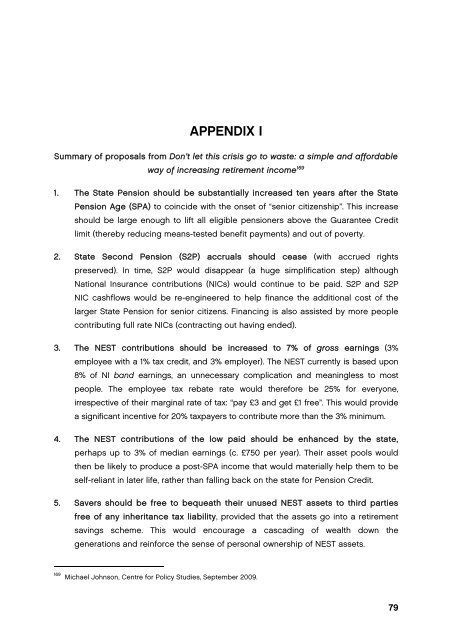Simplification is the key - Centre for Policy Studies
Simplification is the key - Centre for Policy Studies
Simplification is the key - Centre for Policy Studies
You also want an ePaper? Increase the reach of your titles
YUMPU automatically turns print PDFs into web optimized ePapers that Google loves.
APPENDIX I<br />
Summary of proposals from Don’t let th<strong>is</strong> cr<strong>is</strong><strong>is</strong> go to waste: a simple and af<strong>for</strong>dable<br />
way of increasing retirement income 169<br />
1. The State Pension should be substantially increased ten years after <strong>the</strong> State<br />
Pension Age (SPA) to coincide with <strong>the</strong> onset of “senior citizenship”. Th<strong>is</strong> increase<br />
should be large enough to lift all eligible pensioners above <strong>the</strong> Guarantee Credit<br />
limit (<strong>the</strong>reby reducing means-tested benefit payments) and out of poverty.<br />
2. State Second Pension (S2P) accruals should cease (with accrued rights<br />
preserved). In time, S2P would d<strong>is</strong>appear (a huge simplification step) although<br />
National Insurance contributions (NICs) would continue to be paid. S2P and S2P<br />
NIC cashflows would be re-engineered to help finance <strong>the</strong> additional cost of <strong>the</strong><br />
larger State Pension <strong>for</strong> senior citizens. Financing <strong>is</strong> also ass<strong>is</strong>ted by more people<br />
contributing full rate NICs (contracting out having ended).<br />
3. The NEST contributions should be increased to 7% of gross earnings (3%<br />
employee with a 1% tax credit, and 3% employer). The NEST currently <strong>is</strong> based upon<br />
8% of NI band earnings, an unnecessary complication and meaningless to most<br />
people. The employee tax rebate rate would <strong>the</strong>re<strong>for</strong>e be 25% <strong>for</strong> everyone,<br />
irrespective of <strong>the</strong>ir marginal rate of tax: “pay £3 and get £1 free”. Th<strong>is</strong> would provide<br />
a significant incentive <strong>for</strong> 20% taxpayers to contribute more than <strong>the</strong> 3% minimum.<br />
4. The NEST contributions of <strong>the</strong> low paid should be enhanced by <strong>the</strong> state,<br />
perhaps up to 3% of median earnings (c. £750 per year). Their asset pools would<br />
<strong>the</strong>n be likely to produce a post-SPA income that would materially help <strong>the</strong>m to be<br />
self-reliant in later life, ra<strong>the</strong>r than falling back on <strong>the</strong> state <strong>for</strong> Pension Credit.<br />
5. Savers should be free to bequeath <strong>the</strong>ir unused NEST assets to third parties<br />
free of any inheritance tax liability, provided that <strong>the</strong> assets go into a retirement<br />
savings scheme. Th<strong>is</strong> would encourage a cascading of wealth down <strong>the</strong><br />
generations and rein<strong>for</strong>ce <strong>the</strong> sense of personal ownership of NEST assets.<br />
169 Michael Johnson, <strong>Centre</strong> <strong>for</strong> <strong>Policy</strong> <strong>Studies</strong>, September 2009.<br />
79

















